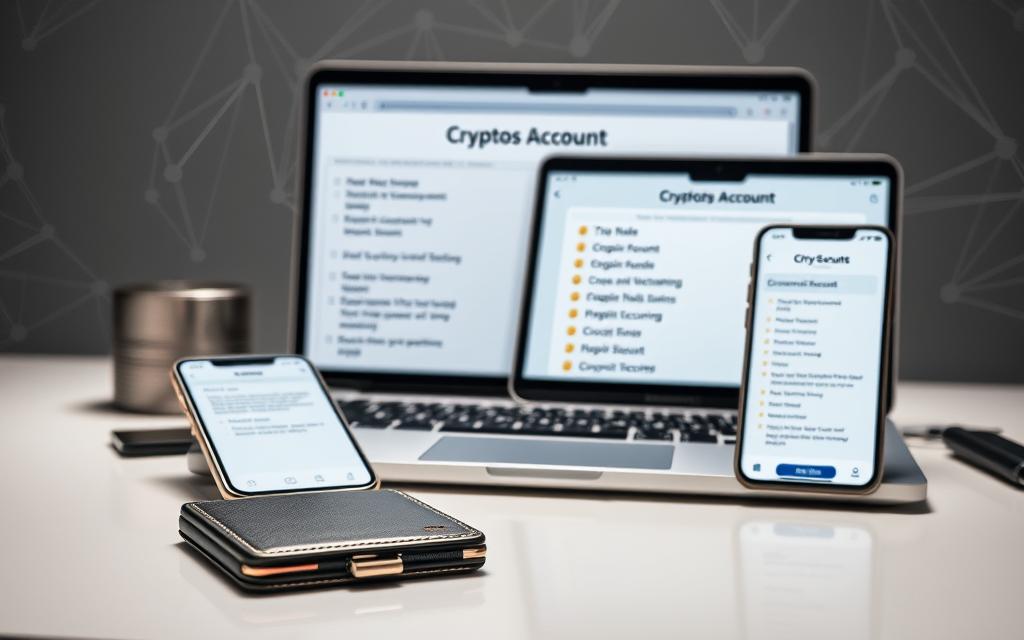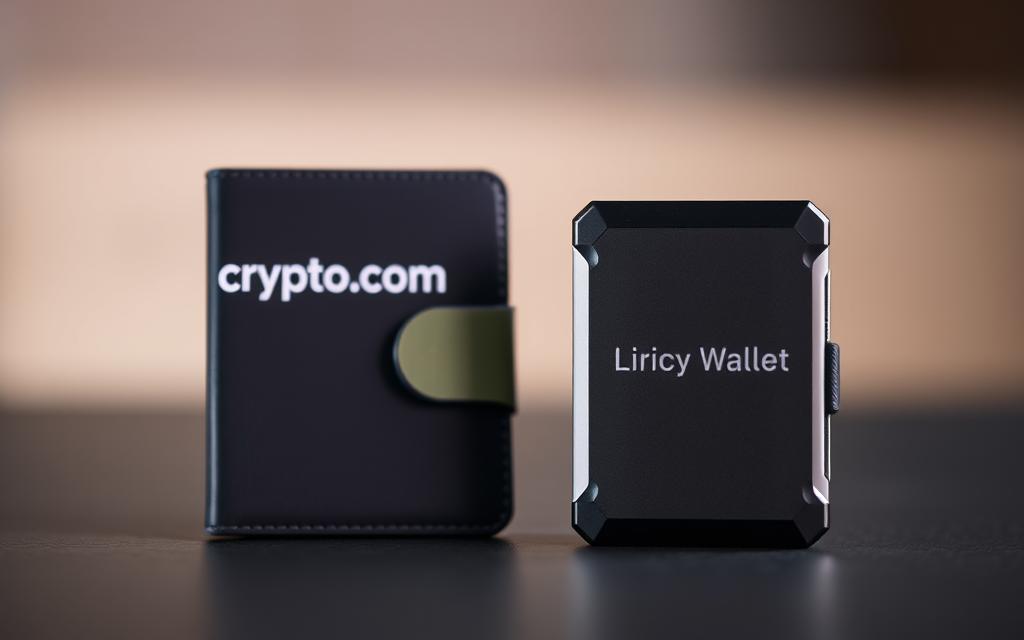Table of Contents
With over 100 million users worldwide, Crypto.com stands as a major player in the digital asset space. Many wonder whether this platform delivers secure and reliable services. Let’s explore its credibility.
The cryptocurrency exchange employs advanced security measures, including cold wallet storage and mandatory multi-factor authentication. A 2022 breach prompted upgrades, reinforcing user protection.
Regulatory compliance across multiple jurisdictions adds another layer of trust. The platform also holds a $150M insurance policy, safeguarding digital assets.
This article examines security protocols, past risks, and how the account safety features stack up today.
Introduction to Crypto.com
Since its launch in 2016, Crypto.com has grown into a global leader in digital finance. Headquartered in Singapore, the platform serves millions with secure, versatile tools for managing digital assets.
What Is Crypto.com?
This platform blends a centralized exchange with decentralized finance (DeFi) options. Users access trading, staking, and even a Visa card for everyday spending. The mobile app simplifies transactions, catering to beginners and experts alike.
Services Offered by Crypto.com
The platform’s standout features include:
- Trading Platform: Buy, sell, and trade 250+ cryptocurrencies with low fees.
- DeFi Wallet: A non-custodial wallet for full asset control.
- Crypto Earn: Earn interest on idle assets, with rates up to 14.5%.
- NFT Marketplace: Trade digital collectibles from top creators.
Notable partnerships, like TIME magazine’s crypto payments integration, highlight its industry influence. The debit card rewards users with cashback in Bitcoin or other tokens.
For those seeking loans, the platform accepts crypto as collateral. Flexible terms and competitive rates make it a viable investment tool.
Is Crypto.com Legit? Evaluating Its Credibility
Trust remains a top concern for digital asset users, making regulatory compliance critical. Crypto.com’s adherence to global standards and third-party audits reinforces its reputation as a secure platform.
Regulatory Licenses and Compliance
The exchange operates under strict oversight, holding a U.S. MSB registration with FinCEN and state-level money transmitter licenses. In Singapore, its Major Payment Institution (MPI) license ensures adherence to anti-money laundering rules.
European users benefit from VASP approvals, aligning with the EU’s rigorous financial frameworks. These regulations mirror safeguards seen in traditional banking, bridging trust gaps.
Industry Certifications and Audits
Independent audits by firms like KPMG validate the company’s operational integrity. Crypto.com also holds ISO 27001 (data security) and PCI DSS (payment safety) certifications, alongside Singapore’s Cyber Trust Mark (Tier 5).
A $150M insurance policy from Arch Underwriting covers digital assets, while ISO 22301 certification guarantees business continuity during disruptions. Such security certifications set a high bar for the industry.
Crypto.com’s Security Features: How It Protects Users
Protecting digital assets requires advanced security measures, and Crypto.com implements several robust features. From cold storage to multi-layered verification, the platform prioritizes user safety.

Cold Wallet Storage and Fund Safety
User funds stay offline in cold wallets, inaccessible to hackers. This 100% cold storage policy minimizes risks from cyberattacks. Regular audits ensure compliance with industry standards.
The platform’s secure software development lifecycle includes:
- Static and dynamic code analysis to detect vulnerabilities.
- Peer reviews for every update, enhancing reliability.
Multi-Factor Authentication (MFA) and Encryption
Mandatory authentication via 2FA adds a critical layer for transactions. SMS or authenticator apps verify identities before approving withdrawals.
Data protection relies on AES-256 encryption, the same standard used by governments. This shields sensitive information during transfers and storage.
Anti-Phishing Measures and Withdrawal Delays
Custom anti-phishing codes prevent fake emails from tricking users. Alerts notify account holders of suspicious login attempts.
A 24-hour delay for new withdrawal addresses blocks unauthorized transactions. Email confirmations add another checkpoint, ensuring only legitimate withdrawals proceed.
“Third-party penetration tests validate Crypto.com’s defenses annually, reinforcing trust in its security framework.”
Potential Risks of Using Crypto.com
Digital asset platforms carry inherent risks, and understanding them helps users make informed decisions. While Crypto.com implements robust safeguards, gaps exist in insurance coverage, authentication methods, and market stability.
FDIC Insurance Limitations
Unlike traditional bank accounts, crypto holdings lack FDIC protection. The platform’s $250M crime insurance covers breaches but not market losses. Users bear full responsibility for asset value fluctuations.
Vulnerabilities in 2FA and Email Alerts
SMS-based two-factor authentication (2FA) exposes accounts to SIM-swapping attacks. Hackers exploit weak carrier protocols to intercept codes. Email notifications may also fail if filters mislabel alerts as spam.
Switching to authenticator apps like Google Authenticator can reduce the risk of losing assets. Regularly updating contact details ensures reliable alerts.
Market Volatility and Platform Dependency
Staked assets face value swings during downturns. Outages or technical glitches could temporarily block access, delaying trades. Spread margins and withdrawal fees may also erode investment returns.
“Regulatory uncertainty adds another layer of risk, as policy changes could impact platform operations.”
Diversifying storage across exchanges and self-custody wallets mitigates these risks.
The 2022 Crypto.com Hack: What Happened and Lessons Learned
In January 2022, a security breach exposed vulnerabilities in Crypto.com’s defenses. Hackers bypassed two-factor authentication (2FA), compromising 483 accounts and stealing $34M in funds. The incident triggered swift reforms to prevent future attacks.

Details of the Security Breach
Attackers exploited a flaw in 2FA protocols, gaining unauthorized transaction approvals. No private keys were compromised, but the breach highlighted risks in SMS-based verification. Third-party forensic teams traced the attack to phishing-linked credentials.
The platform’s cold storage systems remained secure, limiting losses to hot wallets. Affected users received alerts within minutes, though some faced temporary account freezes.
Crypto.com’s Response and Reimbursements
All stolen funds were reimbursed within hours. CEO Kris Marszalek emphasized *“no customer losses”* in public statements. The team also reset 2FA for all users, mandating app-based authenticators for stronger protection.
“Transparency and rapid action restored confidence post-breach,” noted Chainalysis in their 2022 cybersecurity report.
Post-Hack Security Upgrades
The security upgrades included:
- Worldwide Account Protection Program (WAPP): Adds withdrawal whitelisting and 24-hour delay for new addresses.
- Real-time monitoring: AI-driven systems now flag suspicious login patterns.
- Expanded partnerships: Collaborations with CrowdStrike and FireEye enhanced threat detection.
These measures set a new standard for exchange security upgrades, balancing usability with robust safeguards.
How to Secure Your Crypto.com Account
Securing your digital assets starts with proactive account protection. The platform offers robust tools, but users must activate them. Below are key steps to lock down your funds.

Using Authenticator Apps Instead of SMS for 2FA
SMS-based two-factor authentication risks SIM-swapping attacks. Switch to Google Authenticator or Authy for stronger security. These apps generate time-sensitive codes, blocking hackers.
To enable app-based 2FA:
- Navigate to Security Settings in your account.
- Select “Authenticator App” and scan the QR code.
- Store backup codes offline for emergency access.
Setting Up Whitelisted Withdrawal Addresses
Whitelisting adds a 24-hour hold on new withdrawal addresses. This delay prevents unauthorized transfers. Approved addresses bypass the hold after initial verification.
Steps to whitelist:
- Go to Withdrawal Settings and enable “Address Whitelisting.”
- Add trusted wallet addresses manually.
- Confirm via email and authenticator app.
Regular Monitoring and Alerts
Turn on real-time notifications for account activity. Push alerts for logins, trades, and withdrawals help spot breaches early. Review login history weekly.
Additional tips:
- Use a unique, complex password with a manager like Bitwarden.
- Enable session timeouts after 15 minutes of inactivity.
- Audit linked devices monthly under Security settings.
“Layered security measures reduce risks by 90%, according to Security.org’s 2023 report.”
Crypto.com vs. Self-Custody Wallets: Where to Store Crypto
Choosing where to store digital assets impacts security and accessibility. While exchanges like Crypto.com simplify trading, self-custody wallets prioritize user control. This section breaks down the trade-offs.

Pros and Cons of Leaving Assets on Crypto.com
Storing funds on the exchange offers convenience but carries risks. Key advantages include:
- Instant liquidity: Trade or stake assets without transfer delays.
- Insurance coverage: The $150M policy protects against breaches (not market losses).
- Integrated services: Earn interest or spend via the Visa card seamlessly.
Drawbacks involve risk exposure:
- No FDIC protection for crypto holdings.
- Potential platform outages during volatile markets.
- Withdrawal fees (up to 0.0005 BTC per transaction).
Introduction to the Crypto.com DeFi Wallet
The non-custodial DeFi Wallet shifts control to users. Unlike the exchange, it requires managing private keys and recovery phrases. Benefits include:
- Full ownership: No third-party access to funds.
- Lower fees: Direct blockchain interactions avoid exchange margins.
- DApp integration: Connect to decentralized apps like Uniswap.
Setup involves:
- Downloading the app and creating a wallet.
- Safely storing the 12-word recovery phrase offline.
- Transferring digital assets from the exchange.
“Self-custody reduces reliance on intermediaries but demands rigorous storage practices,” notes cybersecurity firm Ledger.
For balanced risk management, many users split holdings between the exchange (for trading) and cold wallets (for long-term storage).
User Experience and Customer Support
Navigating digital finance platforms requires seamless tools and reliable assistance. Crypto.com’s mobile app and customer support aim to balance sophistication with accessibility. Below, we analyze its strengths and areas for improvement.
Ease of Use for Beginners
The app features an intuitive dashboard, but its product suite can overwhelm newcomers. Key highlights:
- Onboarding: Step-by-step guides explain wallet creation and trading. However, advanced tools like margin trading lack beginner-friendly tutorials.
- Interface Customization: Users rearrange modules (e.g., portfolio tracker, market alerts) for personalized workflows.
- Educational Resources: The “Crypto.com University” offers free courses, though some videos lack depth on DeFi concepts.
Customer Support Responsiveness
24/7 in-app live chat ensures immediate help, but response times vary:
| Support Channel | Average Response Time | Availability |
|---|---|---|
| Live Chat | Under 5 minutes (off-peak) | 24/7 |
| 12–24 hours | Business days | |
| Phone | Not offered | N/A |
During peak times, delays extend to 30+ minutes. The debit card issuance takes 7–14 days, with status updates via email.
“Fast resolutions depend on query complexity—simple fixes take minutes, while disputes require days,” reports a 2023 Trustpilot review.
Crypto.com’s Regulatory Standing in the U.S.
State-level approvals determine where Americans can access crypto services. The platform holds licenses across 49 states, excluding New York due to strict BitLicense requirements. This contrasts with competitors like Coinbase, authorized in all 52 U.S. jurisdictions.
Licensing Framework and Geographic Restrictions
FinCEN registration as a Money Services Business (MSB) forms the foundation of compliance. State money transmitter licenses add localized oversight, with varying capital requirements.
Key state-specific conditions:
- Texas: Requires $500K surety bond for custodial services.
- California: Mandates quarterly reporting of transaction volumes.
- Hawaii: Users must complete financial literacy modules.
New York’s exclusion stems from its 2015 BitLicense rules, which demand:
- $5M minimum capital reserves
- Independent cybersecurity audits
- On-premise data storage for NY customers
Competitive Landscape Among U.S. Exchanges
Banking integrations and withdrawal speeds differentiate major exchanges. Crypto.com uses Plaid for encrypted ACH transfers, while competitors employ varied approaches.
| Feature | Crypto.com | Coinbase | Kraken |
|---|---|---|---|
| State Coverage | 49/52 | 52/52 | 48/52 |
| Bank Connections | Plaid (256-bit encryption) | Direct API | Silvergate Exchange Network |
| USD Withdrawal Time | 1-3 business days | Instant (debit card) | Same-day |
| Compliance Certifications | PCI DSS Level 1 | SOC 2 Type 2 | ISO/IEC 27001 |
“Regional regulations create a fragmented landscape—what’s compliant in Nevada may violate Washington law,” observes former CFTC chairman J. Christopher Giancarlo.
Security protocols for USD handling include multi-signature approvals and daily reconciliation. The platform maintains segregated bank accounts at Metropolitan Commercial Bank, ensuring customer funds remain separate from trading reserves.
Conclusion: Is Crypto.com Safe to Use?
Enterprise-grade security safeguards position this exchange as a trusted choice. Cold storage, MFA, and ISO certifications validate its defenses. Yet, users should weigh risks like market swings and partial insurance coverage.
Security.org confirms the platform meets industry standards but advises hardware wallets for large holdings. Beginners benefit from its intuitive tools, while experts may prefer self-custody for full control.
Final verdict? The platform delivers robust protection, but no system is flawless. Enable all security features, diversify storage, and stay informed on regulatory updates.
FAQ
What services does Crypto.com offer?
The platform provides trading, a debit card, staking, lending, and a mobile app for managing digital assets. Users can also access a non-custodial wallet for self-storage.
Is Crypto.com regulated?
Yes, it holds licenses in multiple jurisdictions and complies with financial regulations, including U.S. state-specific requirements for exchanges.
How does Crypto.com protect user funds?
It uses cold wallet storage for most assets, multi-factor authentication (MFA), and encryption to safeguard accounts. Withdrawals may have delays for added security.
What happened during the 2022 security breach?
Hackers bypassed 2FA, compromising accounts. The company reimbursed affected users and strengthened defenses, including mandatory MFA upgrades.
Are funds insured on Crypto.com?
Fiat balances in the app are FDIC-insured up to 0,000, but cryptocurrency holdings rely on the platform’s own insurance and security measures.
How can I improve my account security?
Use authenticator apps for 2FA instead of SMS, whitelist withdrawal addresses, and monitor transactions regularly for unauthorized activity.
Does Crypto.com support U.S. customers?
Yes, though services vary by state due to licensing. Some features, like the exchange, aren’t available in all regions.
How responsive is customer support?
Response times vary, with live chat for urgent issues. Users report mixed experiences, so enabling email alerts helps track resolutions.
Should I store crypto on the exchange or a self-custody wallet?
For long-term holdings, a non-custodial wallet like Crypto.com’s DeFi Wallet reduces reliance on the platform. Active traders may prefer exchange convenience.
What are the risks of using Crypto.com?
Market volatility, potential phishing attacks, and platform outages pose risks. Diversifying storage and enabling security tools mitigates these.









